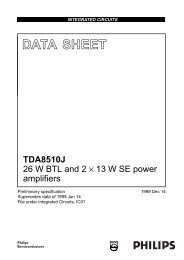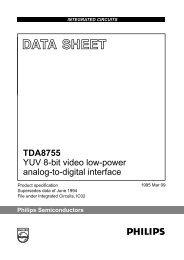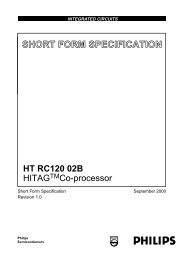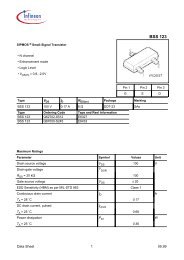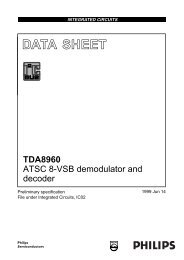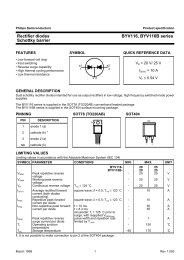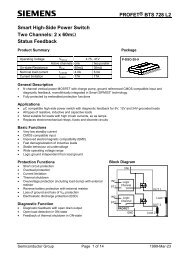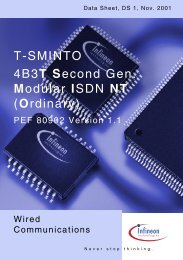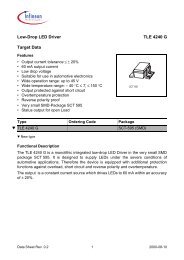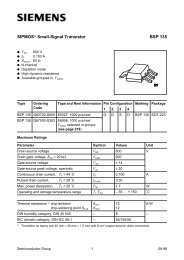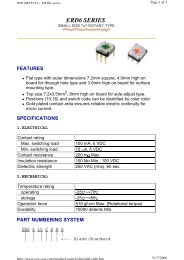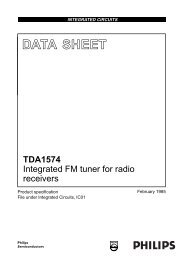Atmel ATMEGA128A-AU datasheet - Octopart
Atmel ATMEGA128A-AU datasheet - Octopart
Atmel ATMEGA128A-AU datasheet - Octopart
Create successful ePaper yourself
Turn your PDF publications into a flip-book with our unique Google optimized e-Paper software.
ATmega128A<br />
2.3.4 Port B (PB7:PB0)<br />
Port B is an 8-bit bi-directional I/O port with internal pull-up resistors (selected for each bit). The<br />
Port B output buffers have symmetrical drive characteristics with both high sink and source<br />
capability. As inputs, Port B pins that are externally pulled low will source current if the pull-up<br />
resistors are activated. The Port B pins are tri-stated when a reset condition becomes active,<br />
even if the clock is not running.<br />
Port B also serves the functions of various special features of the ATmega128A as listed on<br />
page 74.<br />
2.3.5 Port C (PC7:PC0)<br />
Port C is an 8-bit bi-directional I/O port with internal pull-up resistors (selected for each bit). The<br />
Port C output buffers have symmetrical drive characteristics with both high sink and source<br />
capability. As inputs, Port C pins that are externally pulled low will source current if the pull-up<br />
resistors are activated. The Port C pins are tri-stated when a reset condition becomes active,<br />
even if the clock is not running.<br />
Port C also serves the functions of special features of the ATmega128A as listed on page 76. In<br />
ATmega103 compatibility mode, Port C is output only, and the port C pins are not tri-stated<br />
when a reset condition becomes active.<br />
Note:<br />
The ATmega128A is by default shipped in ATmega103 compatibility mode. Thus, if the parts are<br />
not programmed before they are put on the PCB, PORTC will be output during first power up, and<br />
until the ATmega103 compatibility mode is disabled.<br />
2.3.6 Port D (PD7:PD0)<br />
Port D is an 8-bit bi-directional I/O port with internal pull-up resistors (selected for each bit). The<br />
Port D output buffers have symmetrical drive characteristics with both high sink and source<br />
capability. As inputs, Port D pins that are externally pulled low will source current if the pull-up<br />
resistors are activated. The Port D pins are tri-stated when a reset condition becomes active,<br />
even if the clock is not running.<br />
Port D also serves the functions of various special features of the ATmega128A as listed on<br />
page 78.<br />
2.3.7 Port E (PE7:PE0)<br />
Port E is an 8-bit bi-directional I/O port with internal pull-up resistors (selected for each bit). The<br />
Port E output buffers have symmetrical drive characteristics with both high sink and source<br />
capability. As inputs, Port E pins that are externally pulled low will source current if the pull-up<br />
resistors are activated. The Port E pins are tri-stated when a reset condition becomes active,<br />
even if the clock is not running.<br />
Port E also serves the functions of various special features of the ATmega128A as listed on<br />
page 81.<br />
2.3.8 Port F (PF7:PF0)<br />
Port F serves as the analog inputs to the A/D Converter.<br />
Port F also serves as an 8-bit bi-directional I/O port, if the A/D Converter is not used. Port pins<br />
can provide internal pull-up resistors (selected for each bit). The Port F output buffers have symmetrical<br />
drive characteristics with both high sink and source capability. As inputs, Port F pins<br />
that are externally pulled low will source current if the pull-up resistors are activated. The Port F<br />
pins are tri-stated when a reset condition becomes active, even if the clock is not running. If the<br />
8151GS–AVR–07/10<br />
19




